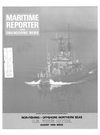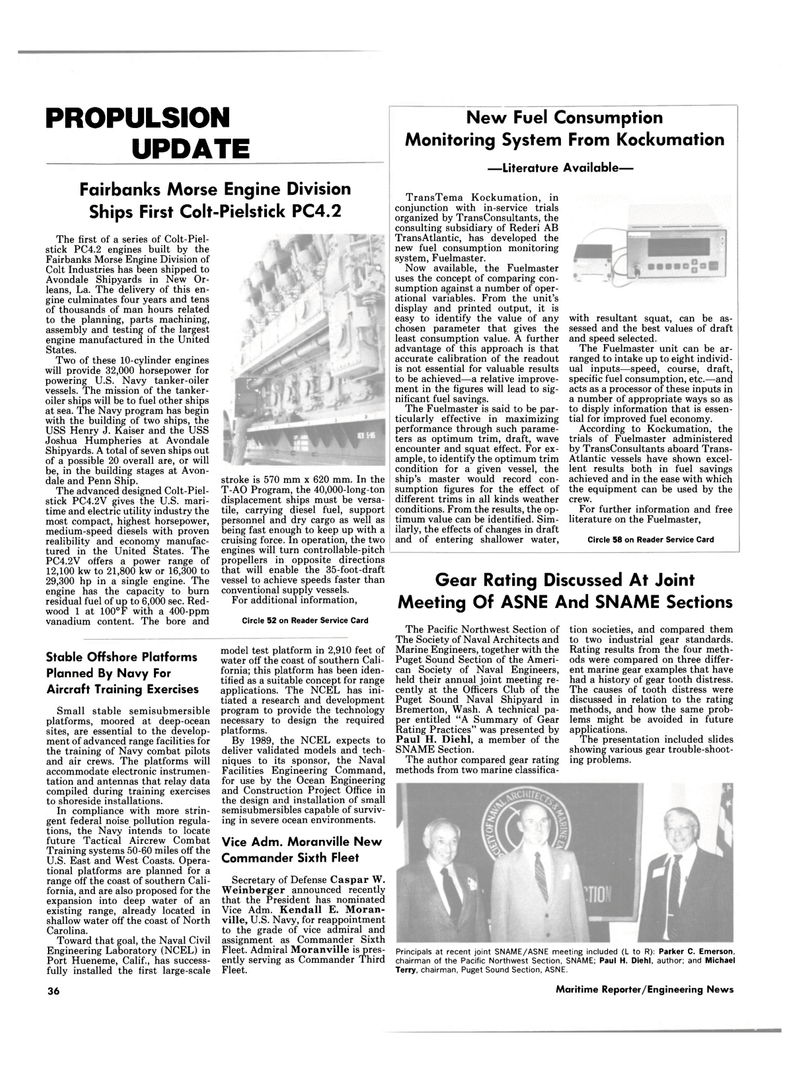
Page 34: of Maritime Reporter Magazine (August 1986)
Read this page in Pdf, Flash or Html5 edition of August 1986 Maritime Reporter Magazine
New Fuel Consumption
Monitoring System From Kockumation —Literature Available—
PROPULSION
UPDATE
Fairbanks Morse Engine Division
Ships First Colt-Pielstick PC4.2
The first of a series of Colt-Piel- stick PC4.2 engines built by the
Fairbanks Morse Engine Division of
Colt Industries has been shipped to
Avondale Shipyards in New Or- leans, La. The delivery of this en- gine culminates four years and tens of thousands of man hours related to the planning, parts machining, assembly and testing of the largest engine manufactured in the United
States.
Two of these 10-cylinder engines will provide 32,000 horsepower for powering U.S. Navy tanker-oiler vessels. The mission of the tanker- oiler ships will be to fuel other ships at sea. The Navy program has begin with the building of two ships, the
USS Henry J. Kaiser and the USS
Joshua Humpheries at Avondale
Shipyards. A total of seven ships out of a possible 20 overall are, or will be, in the building stages at Avon- dale and Penn Ship.
The advanced designed Colt-Piel- stick PC4.2V gives the U.S. mari- time and electric utility industry the most compact, highest horsepower, medium-speed diesels with proven realibility and economy manufac- tured in the United States. The
PC4.2V offers a power range of 12,100 kw to 21,800 kw or 16,300 to 29,300 hp in a single engine. The engine has the capacity to burn residual fuel of up to 6,000 sec. Red- wood 1 at 100°F with a 400-ppm vanadium content. The bore and
Stable Offshore Platforms
Planned By Navy For
Aircraft Training Exercises
Small stable semisubmersible platforms, moored at deep-ocean sites, are essential to the develop- ment of advanced range facilities for the training of Navy combat pilots and air crews. The platforms will accommodate electronic instrumen- tation and antennas that relay data compiled during training exercises to shoreside installations.
In compliance with more strin- gent federal noise pollution regula- tions, the Navy intends to locate future Tactical Aircrew Combat
Training systems 50-60 miles off the
U.S. East and West Coasts. Opera- tional platforms are planned for a range off the coast of southern Cali- fornia, and are also proposed for the expansion into deep water of an existing range, already located in shallow water off the coast of North
Carolina.
Toward that goal, the Naval Civil
Engineering Laboratory (NCEL) in
Port Hueneme, Calif., has success- fully installed the first large-scale stroke is 570 mm x 620 mm. In the
T-AO Program, the 40,000-long-ton displacement ships must be versa- tile, carrying diesel fuel, support personnel and dry cargo as well as being fast enough to keep up with a cruising force. In operation, the two engines will turn controllable-pitch propellers in opposite directions that will enable the 35-foot-draft vessel to achieve speeds faster than conventional supply vessels.
For additional information,
Circle 52 on Reader Service Card model test platform in 2,910 feet of water off the coast of southern Cali- fornia; this platform has been iden- tified as a suitable concept for range applications. The NCEL has ini- tiated a research and development program to provide the technology necessary to design the required platforms.
By 1989, the NCEL expects to deliver validated models and tech- niques to its sponsor, the Naval
Facilities Engineering Command, for use by the Ocean Engineering and Construction Project Office in the design and installation of small semisubmersibles capable of surviv- ing in severe ocean environments.
Vice Adm. Moranville New
Commander Sixth Fleet
Secretary of Defense Caspar W.
Weinberger announced recently that the President has nominated
Vice Adm. Kendall E. Moran- ville, U.S. Navy, for reappointment to the grade of vice admiral and assignment as Commander Sixth
Fleet. Admiral Moranville is pres- ently serving as Commander Third
Fleet.
TransTema Kockumation, in conjunction with in-service trials organized by TransConsultants, the consulting subsidiary of Rederi AB
TransAtlantic, has developed the new fuel consumption monitoring system, Fuelmaster.
Now available, the Fuelmaster uses the concept of comparing con- sumption against a number of oper- ational variables. From the unit's display and printed output, it is easy to identify the value of any chosen parameter that gives the least consumption value. A further advantage of this approach is that accurate calibration of the readout is not essential for valuable results to be achieved—a relative improve- ment in the figures will lead to sig- nificant fuel savings.
The Fuelmaster is said to be par- ticularly effective in maximizing performance through such parame- ters as optimum trim, draft, wave encounter and squat effect. For ex- ample, to identify the optimum trim condition for a given vessel, the ship's master would record con- sumption figures for the effect of different trims in all kinds weather conditions. From the results, the op- timum value can be identified. Sim- ilarly, the effects of changes in draft and of entering shallower water,
The Pacific Northwest Section of
The Society of Naval Architects and
Marine Engineers, together with the
Puget Sound Section of the Ameri- can Society of Naval Engineers, held their annual joint meeting re- cently at the Officers Club of the
Puget Sound Naval Shipyard in
Bremerton, Wash. A technical pa- per entitled "A Summary of Gear
Rating Practices" was presented by
Paul H. Diehl, a member of the
SNAME Section.
The author compared gear rating methods from two marine classifica- with resultant squat, can be as- sessed and the best values of draft and speed selected.
The Fuelmaster unit can be ar- ranged to intake up to eight individ- ual inputs—speed, course, draft, specific fuel consumption, etc.—and acts as a processor of these inputs in a number of appropriate ways so as to disply information that is essen- tial for improved fuel economy.
According to Kockumation, the trials of Fuelmaster administered by TransConsultants aboard Trans-
Atlantic vessels have shown excel- lent results both in fuel savings achieved and in the ease with which the equipment can be used by the crew.
For further information and free literature on the Fuelmaster,
Circle 58 on Reader Service Card tion societies, and compared them to two industrial gear standards.
Rating results from the four meth- ods were compared on three differ- ent marine gear examples that have had a history of gear tooth distress.
The causes of tooth distress were discussed in relation to the rating methods, and how the same prob- lems might be avoided in future applications.
The presentation included slides showing various gear trouble-shoot- ing problems.
Principals at recent joint SNAME/ASNE meeting included (L to R): Parker C. Emerson, chairman of the Pacific Northwest Section, SNAME; Paul H. Diehl, author; and Michael
Terry, chairman, Puget Sound Section, ASNE.
Gear Rating Discussed At Joint
Meeting Of ASNE And SNAME Sections 36 Maritime Reporter/Engineering News

 33
33

 35
35
